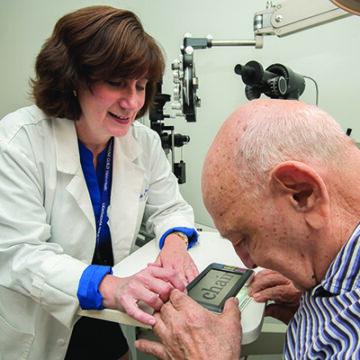News
What Should You Know About Low Vision?
February 5, 2024

Posted by Able News
Written by Jeremy Morak, Marketing Manager, Lighthouse Guild
February is Low Vision Awareness Month. According to the National Eye Institute, 3 million Americans ages 40 and older have low vision. It is crucial to understand what low vision is, how to detect it, and how to take steps toward safety and accessibility if you are living with low vision.
Low vision is a permanent loss of vision that cannot be improved with eyeglasses, contact lenses, medicine, or surgery. Symptoms may include difficulties reading, writing, watching television, driving, recognizing faces, and managing glare. People with low vision may encounter loss of central vision (what you see when looking directly at something), loss of peripheral vision (what you see from the sides of your eyes), problems distinguishing between objects of similar tones (contrast sensitivity), or difficulty judging the position of objects (depth perception).
“The most important thing you can do for your eyes is to get a comprehensive eye exam,” says Dr. Andrea Zimmerman, Low Vision Specialist at Lighthouse Guild. “The three main causes of low vision and blindness in the United States are glaucoma, age-related macular degeneration (AMD), and diabetic eye disease. Only a comprehensive eye exam can detect these diseases in their early stages and help preserve vision.”
If you have vision problems, the sooner you get an eye exam, the sooner you can possibly prevent future vision loss. There are many resources and methods available to navigate the effects of vision loss. New technologies and rehabilitation skills can make daily tasks easier and enhance quality of life. Here are some practical tips for people experiencing low vision.
- Use contrast to distinguish items, such as a dark bathmat with rubber backing on a light floor, a light cutting board on a dark countertop, and white sheets with a dark comforter and pillows.
- Use night lights, a flashlight, or hall or room lighting if you get up during the night.
- Avoid moving quickly from a dark room to a lighted area, and vice versa; give your eyes time to adjust to changing light levels.
- Use overhead lighting to help eliminate shadows and keep rooms evenly lit.
- Use shades on all light sources to reduce glare.
- Sit with your back towards a window or lamp. Use a gooseneck lamp for tabletop activities.
- Embrace technology! Video magnifiers, audio and electronic books, smartphones, and tablets enable you to change the font size and lighting level or magnify what’s on a screen. Apps are also available that can help you identify money and colors and navigate your surroundings.
Join our Mission
Lighthouse Guild is dedicated to providing exceptional services that inspire people who are visually impaired to attain their goals.
